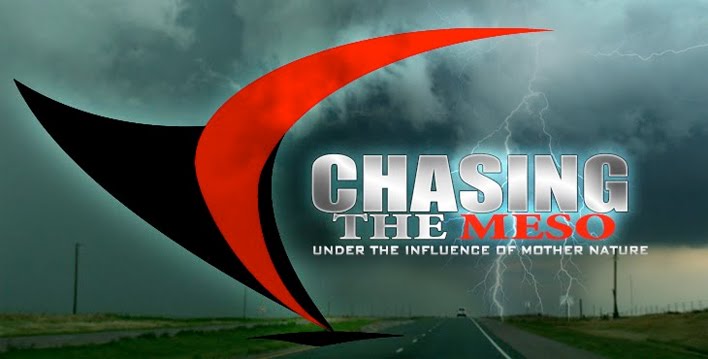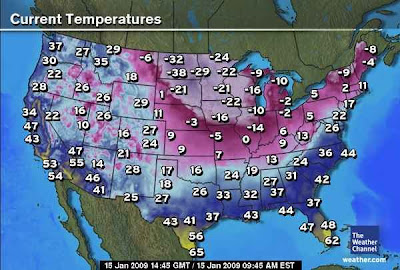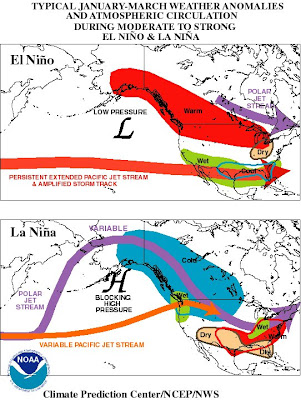The cold air will begin to relax across the Plains and East over the next two weeks. As a pattern change takes over that will promote a stormier pattern but a little warmer one. Here is a look back at December's Temperature Departure from Average. As you can see Arctic air ruled from the Northern and Central Plains east towards the Great Lakes and Ohio Valley. As the Core of the Cold weather was In northern Montana, North Dakota and Minnesota.

The coldest air has shifted a little more south and east in the first 17 days of January. As you can see by the graphic below bitterly cold temperatures across Minnesota and Wisconsin with temperature averaging below normal by 6 to 9 degrees. 
Here is a look at the Ensemble forecast for the next two weeks. Looking at the forecasted NAO, PNA and AO an pattern change will start to take place this week. However it won't really be felt in earnest till the start of February as the cold weather will fight against the impending warmth.
Looking below the trough east of Hawaii is a good indicator for a trough to remain in the east. So until its replaced with a ridge troughs will never stick into the West Coast. As blocking remains across Greenland and over the top of the Pole. Making the cold air continue to funnel in underneath the blocking and into the United States. 
By the end of the month, a ridge starts to replace the trough east of Hawaii that will allow any trough diving south in the West to anchor itself. However blocking remains over Greenland but starts to break down and be replaced with a trough. Now a large ridge over the Pacific in this position doesn't normally promote a large trough along the West Coast. Instead it intensifies the northern branch jet which is fire housed into the West Coast as an active pattern starts to develop across the lower 48 states. As cold or near average cold stays to the north and warmer weather starts to develop along the southern states. 
Large trough starts to develop in the far East along China and Japan by the start of February. Which is a good indicator for Troughs along the West and East Coast. The ridge remains over Hawaii as an southern jet stream starts to become a little more active per this pattern and MJO phase by the start of February. Blocking starts to build over Greenland as Cold weather regains strength over Northern Asia across the North pole into Northwest Canada. So if the Jet stream can buckle, it will likely send another Arctic blast into the lower 48 states by early to mid February. 
So in general the cold weather but not bitterly like the last two weeks will rule over the next 10 days but will begin to weaken by the end of the month. As warmer weather and a pattern flip takes place for at least the start of February. So we up the ante for bigger storms and an very active pattern that will likely last into mid February.


 Here is the latest GFS model 92 hr. Surface map with two examples of storm tracks. Track #1 is an stronger storm that phases all three jet streams as the low turns more northward as it deepens. Track #2 is probably the more likely storm track. Which takes the low more east then north as the upper levels especially the Arctic Jet stream is slower to phase together. So the low pressure slowly deepens until it hits the warmer Atlantic coast. As the warm coastal waters act like a natural baroclinic zone to strengthen and attract the storm to. Both of the storm tracks are subject to change but both yield very heavy snows and possible severe weather for the southeast coast. Blizzard like conditions will develop but will it be across the Ohio Valley and along the west side of the Appalachians or will it be on the east side of them? This has big potential and will be watched closely over the next couple of days.
Here is the latest GFS model 92 hr. Surface map with two examples of storm tracks. Track #1 is an stronger storm that phases all three jet streams as the low turns more northward as it deepens. Track #2 is probably the more likely storm track. Which takes the low more east then north as the upper levels especially the Arctic Jet stream is slower to phase together. So the low pressure slowly deepens until it hits the warmer Atlantic coast. As the warm coastal waters act like a natural baroclinic zone to strengthen and attract the storm to. Both of the storm tracks are subject to change but both yield very heavy snows and possible severe weather for the southeast coast. Blizzard like conditions will develop but will it be across the Ohio Valley and along the west side of the Appalachians or will it be on the east side of them? This has big potential and will be watched closely over the next couple of days.  If you live east of the Mississippi River you'll need to watch closely to the weather forecast over the next week. This could produce heavy snow from Tennessee northeast to Maine with blizzard conditions.
If you live east of the Mississippi River you'll need to watch closely to the weather forecast over the next week. This could produce heavy snow from Tennessee northeast to Maine with blizzard conditions.


 Statement from the National Weather Service in Indianapolis
Statement from the National Weather Service in Indianapolis 














